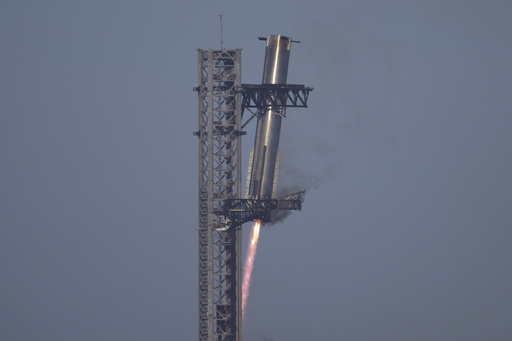CAPE CANAVERAL, Fla. — SpaceX is investigating a potential fire that may have led to the disintegration of its Starship during liftoff, which resulted in flaming debris falling near the Caribbean. According to SpaceX founder Elon Musk, initial assessments suggest that a fuel leak may have increased pressure in the area above the engine firewall, ultimately causing a fire that compromised the spacecraft’s integrity.
The Federal Aviation Administration (FAA) has mandated that SpaceX look into the circumstances surrounding the mishap. Fortunately, there were no reported injuries related to the debris that fell from the Starship.
The Starship, measuring 400 feet in height, is recognized as the largest and most powerful rocket globally. It launched from a site located at the southern tip of Texas on a test mission on Thursday evening. The booster was successfully recovered on the pad using large mechanical arms, marking only the second instance in the history of Starship operations. However, as the spacecraft was ascending, its engines began to fail one after another, leading to a loss of communication after 8 and a half minutes into the flight.
Dramatic footage captured near the Turks and Caicos Islands showed debris from the spacecraft descending in a series of fireballs. As a safety precaution, flights in the vicinity of the debris were rerouted, as stated by the FAA.
SpaceX clarified that the Starship operated within its designated launch corridor over the Gulf of Mexico and the Atlantic Ocean, and any debris that may have survived was likely to have fallen into water along that route.
This test flight was significant as Starship aimed for a controlled landing over the Indian Ocean, halfway around the globe. On board were ten dummy satellites that simulated SpaceX’s Starlink internet satellites, allowing the company to practice the deployment process.
Although this marked the seventh test flight for the Starship, it was notable for featuring new and upgraded systems. The FAA indicated that it will need to approve SpaceX’s findings regarding the accident as well as any corrective actions they plan to take.
SpaceX announced that the booster and spacecraft intended for their eighth demonstration are already constructed and currently undergoing testing. Musk described the mishap on X as “barely a bump in the road” in his larger ambitions to develop a fleet of Starships for potential missions to Mars.
In addition, NASA has already reserved two Starships for landing astronauts on the moon in the upcoming decade, as part of its Artemis program, which serves as a successor to the Apollo missions.
In light of the incident, NASA Administrator Bill Nelson remarked on X, “Spaceflight is not easy. It’s anything but routine. That’s why these tests are so important.”
Earlier on the same day, Jeff Bezos’ Blue Origin experienced mixed outcomes with its inaugural launch of the massive New Glenn rocket. Although it successfully reached orbit on its first attempt and deployed a test satellite thousands of miles above the Earth, the booster was destroyed when it failed to land on a floating platform in the Atlantic Ocean.



